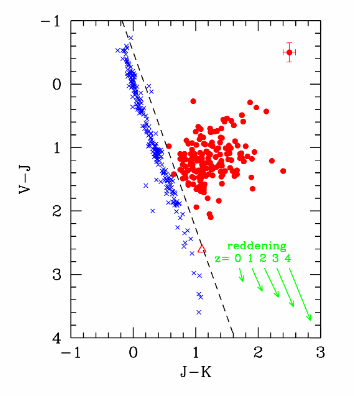KX selected quasars
Over a wide enough wavelength range, quasar spectral energy
distributions are very distinctive. The combination of IR and optical
colours therefore allows a very clean selection of quasars. The
K-excess or KX method has been proposed by Warren, Hewett and Foltz
(2000) and is illustrated in Figure 2.1. As well as providing a clean
selection, the method is very insensitive to reddening, and works over
a wide wavelength range. Extremely large numbers of quasars will be
found, including large numbers of bright quasars suitable for
follow-up work. Such a large complete sample, unbiased against dust,
will be suitable for many statistical projects, and will for example
remove the reddening bias in the evolution of quasars. The scientific
goal we have taken as our key driver is however searches of
special objects - damped Ly-alpha systems, and gravitational lenses.

Figure 2.1. Two colour diagram illustrating the KX
method, from Warren et al. (2000). Here the blue crosses mark the
colours of main-sequence stars, and the red circles mark the colours
of quasars. The arrows show reddening vectors for E(B-V)=0.1 in the
restframe of the intervening absorber at the redshift marked,
indicating that the KX method is insensitive to reddening.
Damped Ly-alpha galaxies and gravitational lenses free of
biases due to dust. In a recent paper Warren, Hewett & Foltz
(2000) explained the motivation for undertaking surveys for bright
high-redshift (here z>2) quasars, flux limited in the K
band. Optically-selected quasars have been used for two important
cosmological studies: (1) the history of gas consumption in star
formation, from the analysis of the statistics of damped Ly-alpha
absorbtion (Pei, Fall & Hauser 1999), and (2) the fraction of quasars
that are gravitationally lensed, which provides information on the
cosmic geometry (Falco, Kochanek & Munoz 1998). The samples of
absorbers and lenses may suffer from a bias, because any absorbers or
lenses containing dust could remove quasars from the optical samples,
and this would have consequences for the conclusions of these studies.
Over 4000 deg2 we estimate there will be 2300 z>2.2 quasars
brighter than K=16, and >10,000 over all redshifts. These would
produce samples of 500 damped Ly-alpha absorbers z>1.8, and about
100 gravitational lenses.
